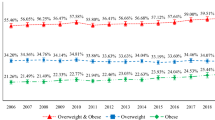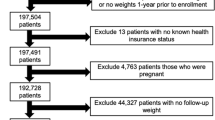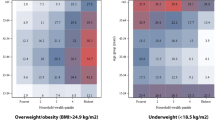Abstract
Objective:
To evaluate the geographic concentration of adult obesity prevalence by census tract (CT) in King County, WA, in relation to social and economic factors.
Methods and design:
Measured heights and weights from 59 767 adult men and women enrolled in the Group Health (GH) healthcare system were used to estimate obesity prevalence at the CT level. CT-level measures of socioeconomic status (SES) were median home values of owner-occupied housing units, percent of residents with a college degree and median household incomes, all drawn from the 2000 Census. Spatial regression models were used to assess the relation between CT-level obesity prevalence and socioeconomic variables.
Results:
Smoothed CT obesity prevalence, obtained using an Empirical Bayes tool, ranged from 16.2–43.7% (a 2.7-fold difference). The spatial pattern of obesity was non-random, showing a concentration in south and southeast King County. In spatial regression models, CT-level home values and college education were more strongly associated with obesity than household incomes. For each additional $100 000 in median home values, CT obesity prevalence was 2.3% lower. The three SES factors together explained 70% of the variance in CT obesity prevalence after accounting for population density, race/ethnicity, age and spatial dependence.
Conclusions:
To our knowledge, this is the first report to show major social disparities in adult obesity prevalence at the CT scale that is based, moreover, on measured heights and weights. Analyses of data at sufficiently fine geographic scale are needed to guide targeted local interventions to stem the obesity epidemic.
This is a preview of subscription content, access via your institution
Access options
Subscribe to this journal
Receive 12 print issues and online access
$259.00 per year
only $21.58 per issue
Buy this article
- Purchase on Springer Link
- Instant access to full article PDF
Prices may be subject to local taxes which are calculated during checkout

Similar content being viewed by others
References
Ogden CL, Lamb MM, Carroll MD, Flegal KM . Obesity and socioeconomic status in adults: United States, 2005-2008. NCHS Data Brief 2010; 50: 1–8.
Mokdad AH, Ford ES, Bowman BA, Dietz WH, Vinicor F, Bales VS et al. Prevalence of obesity, diabetes, and obesity-related health risk factors, 2001. JAMA 2003; 289: 76–79.
Vandegrift D, Yoked T . Obesity rates, income, and suburban sprawl: an analysis of US states. Health Place 2004; 10: 221–229.
Jackson JE, Doescher MP, Jerant AF, Hart LG . A national study of obesity prevalence and trends by type of rural county. J Rural Health 2005; 21: 140–148.
Ewing R, Schmid T, Killingsworth R, Zlot A, Raudenbush S . Relationship between urban sprawl and physical activity, obesity, and morbidity. Am J Health Promot 2003; 18: 47–57.
Drewnowski A, Rehm C, Kao C, Goldstein H . Poverty and childhood overweight in California Assembly districts. Health Place 2009; 15: 631–635.
Drewnowski A, Rehm CD, Solet D . Disparities in obesity rates: analysis by ZIP code area. Soc Sci Med 2007; 65: 2458–2463.
Drewnowski A . Spatial Analyses of Obesity and Poverty. In: Offer A, Pechey R, Ulijaszek S (eds) Proceedings of the British Academy Volume 174. Oxford University Press, 2012.
Holtgrave DR, Crosby R . Is social capital a protective factor against obesity and diabetes? Findings from an exploratory study. Ann Epidemiol 2006; 16: 406–408.
Li W, Kelsey JL, Zhang Z, Lemon SC, Mezgebu S, Boddie-Willis C et al. Small-area estimation and prioritizing communities for obesity control in Massachusetts. Am J Public Health 2009; 99: 511–519.
Zhang Z, Zhang L, Penman A, May W . Using small-area estimation method to calculate county-level prevalence of obesity in Mississippi, 2007-2009. Prev Chronic Dis 2011; 8: A85.
University of Wisconsin Health Policy Institute and Robert Wood Johnson Foundation: County Health Rankings, Mobilizing Action Toward Community Health 2011. Available at http://www.countyhealthrankings.org . Accessed 15 December 2012.
New York City Department of Health and Mental Hygiene. 2006. New York City Community Health Profiles. Available at http://www.nyc.gov/html/doh/html/data/nyc-health-profiles.shtml . Accessed 30 December 2012.
Ford ES, Mokdad AH, Giles WH, Galuska DA, Serdula MK . Geographic variation in the prevalence of obesity, diabetes, and obesity-related behaviors. Obes Res 2005; 13: 118–122.
Liu GC, Cunningham C, Downs SM, Marrero DG, Fineberg N . A spatial analysis of obesogenic environments for children. Proc AMIA Symp 2002; 459–463.
Grow HM, Cook AJ, Arterburn DE, Saelens BE, Drewnowski A, Lozano P . Child obesity associated with social disadvantage of children's neighborhoods. Soc Sci Med 2010; 71: 584–591.
Centers for Disease Control and Prevention. Census Tract Level State Maps of the Modified Retail Food Environment Index (mRFEI). Available at ftp://ftp.cdc.gov/pub/Publications/dnpao/census-tract-level-state-maps-mrfei_TAG508.pdf . Accessed May 15 2013.
Marshall RJ . Mapping disease and mortality rates using empirical Bayes estimators. J R Stat Soc Ser C Appl Stat 1991; 40: 283–294.
Anselin L . The Moran Scatterplot as an ESDA tool to assess local instability in spatial association. In: Fischer M, Scholten H, Unwin D (eds.) Spatial Analytical Perspectives on GIS. Taylor and Francis: London, 1996.
Baron RM, Kenny DA . Moderator-mediator variables distinction in social psychological research: conceptual, strategic, and statistical considerations. J Person Soc Psychol 1986; 51: 1173–1182.
MacKinnon DP, Dwyer JH . Estimating mediated effects in prevention studies. Eval Rev 1993; 17: 144–158.
Slack T, Myers CA, Martin CK, Heymsfield SB . The geographic concentration of US adult obesity prevalence and associated social, economic, and environmental factors. Obesity (Silver Spring) 2013. e-pub ahead of 29 April 2013 doi:10.1016/10.1002/oby.20502.
Barker LE, Kirtland KA, Gregg EW, Geiss LS, Thompson TJ . Geographic distribution of diagnosed diabetes in the US: a diabetes belt. Am J Prev Med 2011; 40: 434–439.
Le A, Judd SE, Allison DB, Oza-Frank R, Affuso O, Safford MM et al. The geographic distribution of obesity in the US and the potential regional differences in misreporting of obesity. Obesity (Silver Spring) 2013. e-pub ahead of print 20 March 2013 doi:10.1002/oby.20451.
Public Health – Seattle and King County. Community Health Indicators, Obesity by Health Reporting Area. Available at http://www.kingcounty.gov/healthservices/health/data/chi2009/RiskAdultObese/HRA.aspx . Accessed 5 June 2013.
Mokdad AH, Bowman BA, Ford ES, Vinicor F, Marks JS, Koplan JP . The continuing epidemics of obesity and diabetes in the United States. JAMA 2001; 286: 1195–1200.
Srebotnjak T, Mokdad AH, Murray CJ . A novel framework for validating and applying standardized small area measurement strategies. Popul Health Metr 2010; 8: 26.
Moudon AV, Cook AJ, Ulmer J, Hurvitz PM, Drewnowski A . A neighborhood wealth metric for use in health studies. Am J Prev Med 2011; 41: 88–97.
Messer LC, Laraia BA, Kaufman JS, Eyster J, Holzman C, Culhane J et al. The development of a standardized neighborhood deprivation index. J Urban Health 2006; 83: 1041–1062.
Singh GK, Kogan MD . Widening socioeconomic disparities in US childhood mortality, 1969 2000. Am J Public Health 2007; 97: 1658–1665.
Chen R, Tunstall-Pedoe H . Socioeconomic deprivation and waist circumference in men and women: the Scottish MONICA surveys 1989-1995. Eur J Epidemiol 2005; 20: 141–147.
Stafford M, Brunner EJ, Head J, Ross NA . Deprivation and the development of obesity a multilevel, longitudinal study in England. Am J Prev Med 2010; 39: 130–139.
Rehm CD, Moudon AV, Hurvitz PM, Drewnowski A . Residential property values are associated with obesity among women in King County, WA, USA. Soc Sci Med 2012; 75: 491–495.
Isaacs SL, Schroeder SA . Class - the ignored determinant of the nation's health. N Engl J Med 2004; 351: 1137–1142.
Krieger N, Waterman PD, Chen JT, Soobader MJ, Subramanian SV . Monitoring socioeconomic inequalities in sexually transmitted infections, tuberculosis, and violence: geocoding and choice of area-based socioeconomic measures—the public health disparities geocoding project (US). Public Health Rep 2003; 118: 240–260.
Krieger N, Chen JT, Waterman PD, Soobader MJ, Subramanian SV, Carson R . Choosing area based socioeconomic measures to monitor social inequalities in low birth weight and childhood lead poisoning: the Public Health Disparities Geocoding Project (US). J Epidemiol Community Health 2003; 57: 186–199.
Braveman PA, Cubbin C, Egerter S, Chideya S, Marchi KS, Metzler M et al. Socioeconomic status in health research: one size does not fit all. JAMA 2005; 294: 2879–2888.
Pollack CE, Chideya S, Cubbin C, Williams B, Dekker M, Braveman P . Should health studies measure wealth? A systematic review. Am J Prev Med 2007; 33: 250–264.
Hajat A, Kaufman JS, Rose KM, Siddiqi A, Thomas JC . Do the wealthy have a health advantage? Cardiovascular disease risk factors and wealth. Soc Sci Med 2010; 71: 1935–1942.
Di ZH, Yang Y, Liu X The Importance of Housing To the Accumulation of Household Net Wealth. Joint Center for Housing Studies, Harvard University, 2003. Available at http://www.jchs.harvard.edu/sites/jchs.harvard.edu/files/w03-5_di.pdf . Accessed 15 February 2012.
Sloan KL, Sales AE, Liu CF, Fishman P, Nichol P, Suzuki NT et al. Construction and characteristics of the RxRisk-V: a VA-adapted pharmacy-based case-mix instrument. Med Care 2003; 41: 761–774.
Acknowledgements
Funding for this project was provided by the National Institutes of Health, grants P20 RR020774-03, R01 DK076608-04 and R21 DK020774.
Author information
Authors and Affiliations
Corresponding author
Ethics declarations
Competing interests
The authors declare no conflict of interest.
Additional information
Supplementary Information accompanies this paper on International Journal of Obesity website
Supplementary information
Rights and permissions
About this article
Cite this article
Drewnowski, A., Rehm, C. & Arterburn, D. The geographic distribution of obesity by census tract among 59 767 insured adults in King County, WA. Int J Obes 38, 833–839 (2014). https://doi.org/10.1038/ijo.2013.179
Received:
Revised:
Accepted:
Published:
Issue Date:
DOI: https://doi.org/10.1038/ijo.2013.179
Keywords
This article is cited by
-
Individual and contextual predictors of overweight or obesity among women in Uganda: a spatio-temporal perspective
GeoJournal (2022)
-
Lifestyle correlates of overweight in adults: a hierarchical approach (the SPOTLIGHT project)
International Journal of Behavioral Nutrition and Physical Activity (2016)



